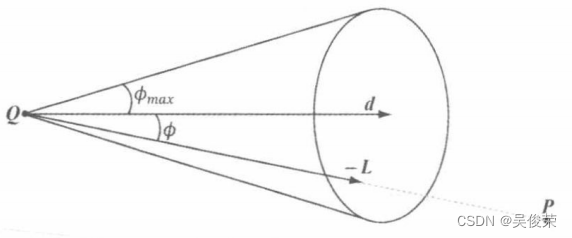Direct3D 12——灯光——聚光灯光

一个与聚光灯光源(spotlight)相近的现实实例是手电筒。从本质上来说,聚光灯由位置Q向方向d 照射出范围呈圆锥体的光。

一个聚光灯以位置Q向方向d发射出半顶角为Φmax 的圆锥体范围的光
其中,P为被照点的位置,Q是聚光灯的位置。 观察图可知,当且仅当位于 -L 与 d 之间的夹 角。小于圆锥体的半顶角Φmax时,P才位于聚光灯 的圆锥体范围之中(所以它才可以被光照射到)。 而且,聚光灯圆锥体范围内所有光线的强度也不尽 相同。位于圆锥体中心处的光线(即Qd这条向量 上的光线)光强应该是最强的,而随着角Φ由 0 增加至Φmax ,光强会逐渐趋近于0。
那么,怎样用与Φ相关的函数来控制光强的衰减 我们可以使用与图中曲线相同的函数,但是要以Φ替换θh ,再用s代替m:

这正是我们所期待的公式:光强随着Φ的增加而连续且平滑地衰减。另外,通过修改幕、s,我们就 能够间接地控制Φmax(使光强降为0的半顶角角度)。也就是说,我们可以通过设置不同的s值来缩小或 扩大聚光灯光源的圆锥体照射范围。例如,如果设s = 8,则圆锥体的半顶角就逼近45。
将光源的直射光量与衰减因子相乘之后,还要根据被照射点位于聚光灯圆锥体的具体位置, 用聚光灯因子kspot按比例对光强进行缩放。
实现
//实现了一种线性衰减因子的计算方法,可将其应用于点光源于聚光灯
float CalcAttenuation(float d, float falloffStart, float falloffEnd)
{// Linear falloff.return saturate((falloffEnd-d) / (falloffEnd - falloffStart));
}//代替菲涅尔方程的石里克近似。此函数基于光向量L于表面法线n之间的夹角,并根据菲涅尔效应近似地计算出以n为法线的表面所反射光的百分比
// Schlick gives an approximation to Fresnel reflectance (see pg. 233 "Real-Time Rendering 3rd Ed.").
// R0 = ( (n-1)/(n+1) )^2, where n is the index of refraction.
float3 SchlickFresnel(float3 R0, float3 normal, float3 lightVec)
{float cosIncidentAngle = saturate(dot(normal, lightVec));float f0 = 1.0f - cosIncidentAngle;float3 reflectPercent = R0 + (1.0f - R0)*(f0*f0*f0*f0*f0);return reflectPercent;
}//计算反射到观察者眼中的光量,该值为漫反射光量于镜面反射光量的总和
float3 BlinnPhong(float3 lightStrength, float3 lightVec, float3 normal, float3 toEye, Material mat)
{//m由光泽度推导而来,而光泽度则根据粗糙度求得const float m = mat.Shininess * 256.0f;float3 halfVec = normalize(toEye + lightVec);float roughnessFactor = (m + 8.0f)*pow(max(dot(halfVec, normal), 0.0f), m) / 8.0f;float3 fresnelFactor = SchlickFresnel(mat.FresnelR0, halfVec, lightVec);float3 specAlbedo = fresnelFactor*roughnessFactor;//尽管我们进行的是LDR(low dynamic range .低动态范围)渲染,但spec(镜面反射)公式得到// 的结果仍会超出范围[0,1],因此现将其按比例缩小一些// Our spec formula goes outside [0,1] range, but we are // doing LDR rendering. So scale it down a bit.specAlbedo = specAlbedo / (specAlbedo + 1.0f);return (mat.DiffuseAlbedo.rgb + specAlbedo) * lightStrength;
}//聚光灯
float3 ComputeSpotLight(Light L, Material mat, float3 pos, float3 normal, float3 toEye)
{//从表面指向光源的向量// The vector from the surface to the light.float3 lightVec = L.Position - pos;//由表面到光源的距离// The distance from surface to light.float d = length(lightVec);//范围检测// Range test.if(d > L.FalloffEnd)return 0.0f;//对光向量进行规范化处理// Normalize the light vector.lightVec /= d;//通过朗伯余弦定律按比例缩小光的强度// Scale light down by Lambert's cosine law.float ndotl = max(dot(lightVec, normal), 0.0f);float3 lightStrength = L.Strength * ndotl;//根据距离计算光的衰减// Attenuate light by distance.float att = CalcAttenuation(d, L.FalloffStart, L.FalloffEnd);lightStrength *= att;//根据聚光灯照明模型对光强进行缩放处理// Scale by spotlightfloat spotFactor = pow(max(dot(-lightVec, L.Direction), 0.0f), L.SpotPower);lightStrength *= spotFactor;return BlinnPhong(lightStrength, lightVec, normal, toEye, mat);
}


